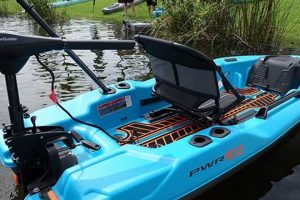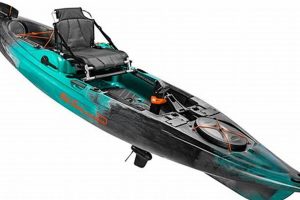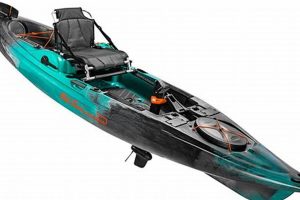Selecting appropriate fishing line is crucial for kayak anglers. Different fishing styles and target species require specific line properties. Factors such as breaking strength, diameter, abrasion resistance, visibility, and stretch influence line selection. For instance, braided line offers high strength and sensitivity, making it suitable for battling strong fish in heavy cover, while fluorocarbon’s low visibility excels in clear water situations. Monofilament remains a versatile and cost-effective choice for many general fishing applications.
Optimized line choice significantly improves angling success from a kayak. A line well-suited to the environment and target species increases hook-up ratios, minimizes break-offs, and enhances overall fishing experience. Using the wrong line can lead to lost fish, wasted time, and frustration. Historically, anglers had limited line options, but modern advancements offer specialized lines catering to specific fishing techniques and conditions, significantly impacting kayak fishing success.
The subsequent sections will explore specific line characteristics relevant to kayak fishing, recommend lines based on target species and fishing styles, and offer guidance on proper line management and maintenance techniques for optimal performance on the water.
Tips for Line Selection in Kayak Fishing
Optimal line choice is paramount for successful kayak angling. These tips provide guidance on selecting and managing fishing line for various species and techniques.
Tip 1: Consider Target Species: Larger, stronger fish necessitate lines with higher breaking strength. Smaller species can be targeted with lighter lines, maximizing sensitivity and casting distance.
Tip 2: Match Line to Fishing Style: Techniques like topwater fishing benefit from floating lines, while bottom fishing often requires sinking lines. Braided lines excel in heavy cover, while fluorocarbon is ideal in clear water.
Tip 3: Prioritize Abrasion Resistance: Kayak fishing often involves fishing near structure. Line with high abrasion resistance minimizes break-offs around rocks, docks, and vegetation.
Tip 4: Factor in Water Clarity: In clear water, low-visibility lines like fluorocarbon are less likely to spook fish. Highly visible lines can be advantageous in murky water or low-light conditions.
Tip 5: Understand Line Stretch: Low-stretch lines like braid offer greater sensitivity and hook-setting power, while high-stretch lines like monofilament provide shock absorption when fighting strong fish.
Tip 6: Manage Line Effectively: Proper spooling prevents tangles and maximizes casting distance. Regularly check for nicks and abrasions, replacing damaged line as needed.
Tip 7: Carry Extra Line: Bringing extra spools of line in different strengths and types ensures preparedness for various fishing scenarios and potential line breakage.
Implementing these tips will lead to improved hook-up ratios, fewer lost fish, and an overall more enjoyable kayak fishing experience.
By understanding the nuances of line selection and management, anglers can optimize their approach and enhance their success on the water.
1. Breaking Strength
Breaking strength, a critical factor in line selection for kayak fishing, represents the maximum force a line can withstand before snapping. Matching breaking strength to target species and fishing conditions directly impacts angling success. Overly strong lines sacrifice casting distance and sensitivity, while lines with insufficient strength lead to break-offs and lost fish. For example, targeting large saltwater species like tuna or grouper requires lines with significantly higher breaking strength compared to lines used for freshwater panfish. Understanding the relationship between breaking strength and target species is crucial for optimizing tackle and maximizing catch rates.
Choosing the appropriate breaking strength often involves balancing strength with finesse. Kayak anglers frequently encounter complex underwater structures and vegetation. In such scenarios, a slightly higher breaking strength provides a margin of safety when wrestling fish from heavy cover. However, unnecessarily high breaking strength can hinder casting performance, especially in windy conditions or when using lighter lures. A practical approach involves selecting a line with adequate strength to handle the target species while remaining thin enough for optimal casting and presentation.
Successfully selecting line based on breaking strength requires careful consideration of target species, fishing environment, and desired lure presentation. Balancing strength and finesse allows anglers to confidently handle strong fish while maintaining optimal casting performance and sensitivity. This informed approach leads to increased hook-up ratios, fewer lost fish, and a more rewarding kayak fishing experience. The next section will explore another crucial aspect of line selection: abrasion resistance.
2. Abrasion Resistance
Abrasion resistance is a critical factor in line selection for kayak fishing, significantly impacting line longevity and angling success. Kayak fishing often involves navigating tight spaces and encountering abrasive structures like rocks, barnacles, and submerged timber. A line’s ability to withstand friction against these surfaces is crucial for preventing premature breakage and lost fish.
- Line Material and Construction
Different line materials and construction methods influence abrasion resistance. Braided lines, constructed from interwoven fibers, generally offer superior abrasion resistance compared to monofilament or fluorocarbon. However, the tightness of the braid and the material coatings also play a role. Fused lines, a variation of braided lines, offer enhanced abrasion resistance due to their smoother, more tightly woven construction.
- Environmental Factors
The fishing environment significantly impacts line wear. Fishing around sharp rocks, oyster beds, or heavy vegetation demands lines with higher abrasion resistance. In contrast, fishing in open water or over sandy bottoms poses less risk of abrasion. Understanding the fishing environment and selecting line accordingly is essential for maximizing line life and minimizing break-offs.
- Fishing Techniques
Certain fishing techniques increase the likelihood of line abrasion. Bottom fishing, especially around structure, exposes the line to constant friction. Similarly, techniques like flipping and pitching, where lures are frequently dragged through cover, necessitate lines with high abrasion resistance. Conversely, techniques like trolling in open water place less stress on the line.
- Line Maintenance
Proper line maintenance plays a crucial role in preserving abrasion resistance. Regularly checking for nicks, cuts, and abrasions and replacing damaged sections extends line life. Avoiding sharp edges on rods, reels, and kayak components also helps prevent unnecessary wear. Proper spooling and line management further contribute to minimizing friction and maximizing line performance.
Selecting a line with appropriate abrasion resistance directly impacts success and efficiency in kayak fishing. By considering the interplay of line material, fishing environment, fishing techniques, and line maintenance, anglers can optimize their tackle and minimize frustrating line failures. This understanding allows for confident fishing in demanding environments, maximizing catch rates and overall enjoyment on the water.
3. Visibility
Line visibility is a crucial factor influencing fishing success, particularly in kayak fishing where anglers often operate in close proximity to their target species. The degree to which a fishing line is visible or invisible underwater directly impacts fish behavior and, consequently, catch rates. Selecting the appropriate line visibility involves carefully considering water clarity, target species, and fishing techniques.
- Water Clarity
In clear water conditions, low-visibility lines, such as fluorocarbon, offer a significant advantage. Their refractive index closely matches that of water, making them nearly invisible to fish. This reduced visibility minimizes spooking wary species, increasing the likelihood of strikes. Conversely, in murky or stained water, high-visibility lines can be beneficial. Brightly colored lines, like chartreuse or orange, allow anglers to easily track line movement and detect subtle bites, especially in low-light conditions.
- Target Species
Different species exhibit varying degrees of sensitivity to line visibility. Species inhabiting clear, shallow environments tend to be more cautious and easily spooked by visible lines. In such scenarios, low-visibility lines are essential for maximizing success. However, less wary species in deeper or murky water may not be as affected by line visibility, allowing for the use of more visible lines without significant impact on catch rates.
- Fishing Techniques
Specific fishing techniques necessitate different levels of line visibility. For techniques like sight fishing, where anglers visually locate and target individual fish, low-visibility lines are crucial for remaining undetected. In contrast, techniques where line visibility aids in strike detection, such as topwater fishing or fishing in heavy cover, may benefit from high-visibility lines. The angler’s ability to track the line and quickly react to bites becomes more important than perfect camouflage.
- Line Color and Camouflage
Line manufacturers offer various colors and camouflage patterns designed to blend with specific underwater environments. Green or brown lines may blend well in weedy or rocky areas, while blue or clear lines are suited for open water. While specialized camouflage lines can offer advantages in certain situations, the primary consideration remains overall visibility based on water clarity and target species behavior.
Optimizing line visibility for specific kayak fishing scenarios requires a balanced assessment of water clarity, target species behavior, and fishing techniques. Strategic line selection based on these factors significantly enhances presentation, minimizes spooking wary fish, and ultimately increases angling success. By carefully considering the role of visibility, kayak anglers can refine their approach and improve their chances of landing their desired catch.
4. Stretch
Line stretch, an inherent characteristic of all fishing lines, significantly influences hooksets, fish fighting, and lure action in kayak fishing. Understanding the implications of line stretch is essential for selecting the optimal line and maximizing angling success. Different line types exhibit varying degrees of stretch, each with advantages and disadvantages in specific fishing scenarios.
- Hooksetting Power and Sensitivity
Low-stretch lines, such as braided lines, transmit even the slightest bites directly to the angler, enhancing sensitivity and allowing for immediate, powerful hooksets. This characteristic is particularly advantageous when fishing in heavy cover or targeting fish with hard mouths. High-stretch lines, like monofilament, absorb some of the hookset force, requiring more forceful hooksets, particularly at longer distances. However, this stretch can be beneficial when targeting fish with softer mouths, reducing the chance of the hook pulling free.
- Fish-Fighting Control
Line stretch plays a critical role during the fight. Low-stretch lines offer direct control over the fish, allowing for quick turns and precise pressure adjustments. This control is essential when battling strong fish near structure or in fast currents. High-stretch lines provide a cushioning effect, absorbing sudden surges and reducing the risk of line breakage. This characteristic can be advantageous when fighting large, powerful fish in open water.
- Lure Action and Presentation
Line stretch influences lure action and presentation. Low-stretch lines transmit rod movements directly to the lure, enabling precise control over retrieves and enhancing the action of certain lures, like crankbaits and jerkbaits. High-stretch lines can dampen lure action, which can be beneficial for techniques like finesse fishing where subtle presentations are key. The degree of stretch influences how the lure responds to rod movements and currents, affecting its attractiveness to fish.
- Line Materials and Stretch Characteristics
Different line materials exhibit varying degrees of stretch. Braided lines have minimal stretch, fluorocarbon has low stretch, and monofilament has moderate to high stretch. Understanding the stretch characteristics of each line type is crucial for selecting the appropriate line for specific fishing scenarios. Factors such as line diameter and construction also influence stretch within each line type.
Selecting the appropriate line stretch for kayak fishing requires carefully balancing sensitivity, hooksetting power, fish-fighting control, and lure action. Matching line stretch to target species, fishing environment, and fishing techniques significantly impacts angling success. By understanding the nuances of line stretch, kayak anglers can optimize their tackle and improve their chances of landing their target species.
5. Diameter
Line diameter is a crucial factor influencing casting distance, fishing depth, line capacity, and sensitivity in kayak fishing. Selecting the appropriate diameter involves balancing these considerations to optimize fishing effectiveness and overall experience. Thinner lines generally offer better casting performance and deeper diving capabilities, while thicker lines provide increased strength and abrasion resistance but sacrifice casting distance and sensitivity. Understanding the implications of line diameter is essential for making informed decisions when selecting the best line for specific fishing situations.
- Casting Distance
Thinner diameter lines offer reduced wind resistance and less friction against rod guides, resulting in longer casts. This characteristic is particularly advantageous in kayak fishing, where reaching distant targets is often crucial. Thicker lines, while stronger, sacrifice casting distance due to increased wind resistance and friction.
- Fishing Depth
Line diameter influences lure depth and fishing presentation. Thinner lines cut through the water more efficiently, allowing lures to reach desired depths faster. This is especially important for techniques like deep-water jigging or trolling. Thicker lines create more resistance, hindering lure descent and impacting the intended presentation.
- Line Capacity
Line diameter directly affects the amount of line that can be spooled onto a reel. Thinner lines allow for greater line capacity, which can be crucial when targeting large, powerful fish that may take long runs. Thicker lines reduce overall line capacity, potentially limiting fishing options in certain scenarios.
- Sensitivity
While not as significant a factor as stretch, line diameter does influence sensitivity. Thinner lines transmit vibrations and bites more efficiently to the angler, enhancing bite detection. Thicker lines, while more durable, can slightly dampen sensitivity, potentially leading to missed strikes.
Optimizing line diameter selection for kayak fishing requires a balanced approach, considering casting distance, fishing depth, line capacity, and sensitivity. Matching line diameter to target species, fishing environment, and fishing techniques is crucial for maximizing efficiency and angling success. Understanding the interplay of these factors empowers anglers to make informed decisions, resulting in improved casting performance, better lure presentation, increased line capacity, and enhanced sensitivity, ultimately contributing to a more productive and enjoyable kayak fishing experience.
Frequently Asked Questions
This section addresses common inquiries regarding fishing line selection for kayak angling.
Question 1: What is the most versatile line type for kayak fishing?
While specialized lines excel in specific situations, monofilament offers a balance of affordability, versatility, and ease of use, making it suitable for various species and techniques.
Question 2: Does line color truly matter in kayak fishing?
Line color significantly impacts visibility. In clear water, low-visibility lines like fluorocarbon are less likely to spook fish. High-visibility lines aid in strike detection in murky water or low-light conditions.
Question 3: How often should fishing line be replaced?
Line should be inspected regularly for nicks, abrasions, and wear. Replacement frequency depends on usage, fishing environment, and line type. Replacing line after heavy use or encountering abrasive structures is recommended.
Question 4: What are the advantages of braided line for kayak fishing?
Braided line offers superior strength, minimal stretch, and exceptional abrasion resistance, making it ideal for fishing around heavy cover or targeting strong fish. However, it is more visible and requires specific knot-tying techniques.
Question 5: Can fluorocarbon line be used for all kayak fishing applications?
While fluorocarbon excels in clear water due to its low visibility, its lower stretch and higher cost may not make it the ideal choice for all situations. Its specific properties are best suited for finesse presentations and targeting wary fish in clear water.
Question 6: How does kayak fishing influence line choice compared to shore fishing?
Kayak fishing often involves closer proximity to fish and navigating tighter spaces. This emphasizes the importance of line characteristics like visibility and abrasion resistance. Kayak anglers may prioritize these factors more heavily than shore anglers.
Understanding these key aspects of line selection empowers anglers to make informed decisions and enhance their kayak fishing experience. Addressing these common concerns clarifies the importance of matching line properties to specific fishing scenarios.
For further information on specific line recommendations and techniques, consult the following resources
Conclusion
Optimal line selection significantly impacts kayak fishing success. Factors like breaking strength, abrasion resistance, visibility, stretch, and diameter influence line performance in various fishing scenarios. Matching these characteristics to target species, fishing environment, and techniques maximizes efficiency and catch rates. While monofilament offers versatility, specialized lines like braid and fluorocarbon excel in specific conditions. Understanding these nuances empowers anglers to make informed decisions, enhancing their overall fishing experience.
Strategic line selection, based on careful consideration of these factors, elevates kayak angling from a recreational pastime to a refined pursuit. Continuous exploration of line properties and advancements in line technology promises further enhancement of fishing performance and enjoyment on the water. Ultimately, the “best” line isn’t a universal solution but rather a tailored choice reflecting individual fishing preferences and the dynamic interplay of angling variables.






